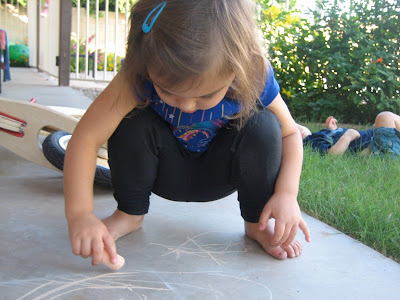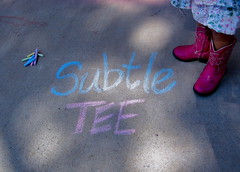If you feel like sewing with knits is a stretch check out a few of these tips and tricks I so wisely know have discovered by accident that seem to make those darn stretchy fabrics play nice!
Check out:
#1- Needle, needle, needle
#2- Set the right stitch type and length
#3- Tame those hungry feed dogs
#4- Thread Counts
#5- Release a little tension would ya?
#1- Needle, needle, needle
The type of needle you use on your machine is the key to success above all else. Especially for light weight knits and jersey fabric (like t-shirts). I use a ballpoint needle (sometimes called a Jersey needle), but you can also use a stretch needle. These fancy needles have a rounded point that penetrates the fabric without catching or cutting through the yarns.
#2- Set the right stitch type and length
I'm sure you've heard a zigzag stitch recommended when sewing elastics or knits and it's because the zig lets the stitch flex and give a little with the movement of the material. This makes it easy because you don't have to stretch the fabric as you sew. The best setting for a zigzag machine is the narrowest zigzag setting (.5mm on many machines) and a stitch length of 2.5mm to 3mm. For those super thick knits you can use a longer stitch length.
For those with a straight-stitch-only machine don't worry! Just set your stitch length to a medium (2.5mm-3mm) length and it should work just fine. The only catch is when sewing knits with a straight stitch, you need to very carefully and evenly stretch the fabric from both ends. This doesn't have to be a tug-a-war, you just slightly and gently stretch the fabric as it goes under the presser foot. Make sure you're not pulling on one end or the other though, because you could end up pulling and snapping the needle. Yikes! No matter how cranky your kids are all day I doubt anyone really wants to poke their eyes out with a needle.
#3 Tame those hungry feed dogs!
If you have a differential feed system on your machine count your lucky stars! Your manual should have some info on the best setting for knits. The feed dogs are the little spikes at the plate of the machine that "feed" the fabric through while you sew. This is also what makes the knit fabrics sometimes stretch too much or pucker when they're pulled through too tightly.
How do I know what I have???
Most basic sewing machines have a single feed which feeds all layers through together, at the same time. You can test to see if yours does by taking two of the exact same size pieces of fabric and sewing a seam down the center. After you remove them from under the presser foot check the edges of the fabric to see if they are still aligned. If so, then hooray your feed is working well! If not, well shoot, those dogs are pulling either the top or the bottom piece faster than the other. No big deal, you should be able to check your manual and adjust the feed, but it'll require a little trouble shooting back and forth with test strips until you get it.
Having the feed dogs balanced will help, but if you still have too much pull or puckering you can try easing the pressure on the presser foot. I've also heard, but not yet tested that you can put a piece of paper under the fabric before you feed it through the machine to basically eliminate the feed dogs altogether! I've heard it really helps, but you'll have to make sure you're good at evenly and gently stretching the fabric through on both sides. Then, once you're done sewing you just pull the paper out of the seams.
If you're using a serger and having problems with the knits bunching, pulling or puckering, you can also check your feed dogs. Most sergers come with a differential feed knob that you can turn to strengthen or loosen as needed.
Warning about serging with knits.... the serge stitch takes away most of the stretch in the fabric, so it's actually better to sew neck openings or tightly fitted cuffs with a zigzag so they can stretch with the material over the head, hands or feet.
#4- Thread counts
The type of thread that is. Using the lightest weight possible will limit bunching. Instead of the basic cotton thread see how nylon thread works for you
#5- Release a little tension would ya?
For knit fabrics and most stretch material you'll probably need to loosen the bobbin tension, especially if you're working with cotton thread. Always test on a scrap piece of fabric after making any changes. The best stitches for a knit should lay almost flat with a slight raise. Give the fabric a little stretch to make sure the stitches don't break. If you've gone too loose you'll know because the stitches will form “loops” rather than stitches and won't lay flat.
Other random tips
- Always pre-wash knits, because they do definitely shrink.
- Skip the seam finishes! Most knits don't unravel much anyway and the less sewing the less room for unwanted stretch.
- Spray a little ironing starch on the ends to give them some extra stiffness while you're working.
- Sounds too basic to even say, but make sure your machine is recently oiled so the thread doesn't have extra pull coming through.
- Use a double row of stitches on the hem. I'm sure you've noticed that most professional knits use this and unfortunately, they're fancier than most of use SAHM sewers and use a special machine or fancy serger to make this "coverstitch." But even if you don't have a coverstitch most zigzag sewing machines can take double needles, which sews a perfect double row of stitches on the needle side of the fabric and a neat zigzag on the bottom! This stitch has more stretch than a regular stitch and looks impressively professional :) The only drawback is that when you change to a double needle you'll probably have to make some other adjustments to your needle and bobbin tensions. If you want to try this hop over and check out this tutorial for twin needle sewing here.
I hope this helps!
Please email me or comment away if you've discovered any other tips, I'd love to know!!!
And.... just because I can't possibly have a post without pictures I'll seize the opportunity to show you Sienna's favorite moment of all from our little cabin trip last week.
 Sitting in an old fashion high chair and eating oreo cookies
Sitting in an old fashion high chair and eating oreo cookies
(it was a tie between the chair or the cookies)
 Drinking her "milk-ooo" out of a fancy Sienna size real glass.
Drinking her "milk-ooo" out of a fancy Sienna size real glass.

Puckering like a knit fabric when we laughed at her milk mustache.
 Trying desperately to hide the "hairs" of her milk mustache to get us to stop giggling at her
Trying desperately to hide the "hairs" of her milk mustache to get us to stop giggling at her.
Ooooh kids are so fun, can you blame us for getting our kicks where we can??



 I made sure to cut the sleeves and the bottom of the shirt along the original tee-shirt hem, so I saved a step in the hemming process!
I made sure to cut the sleeves and the bottom of the shirt along the original tee-shirt hem, so I saved a step in the hemming process!





















































































